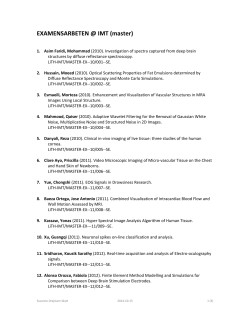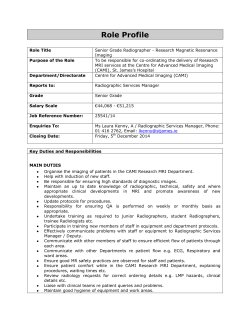
5988 NLB Brain TG
TEACHER’S GUIDE the new Living body THE BRAIN FILMS FOR THE HUMANITIES & SCIENCES ® 5988 Program Summary This program opens in the emergency room of a large hospital where we see that people suffering from head injuries are an all-too-common problem. The importance of the brain is evident from the skill and technology employed in ensuring that any damage to it is minimized. Using combinations of computerized tomography (CT), magnetic resonance imaging (MRI), and advanced surgical techniques, we show why the brain is so important and explore what is known about how it works. Background Information Images of the Body Until relatively recently, most of our knowledge about the brain came from highly invasive experiments on monkeys. The procedures often involved vivisection techniques, which many people found unacceptable, and produced results that could not always be reliably applied to humans. Now neuroscientists can turn to new technology to help them solve the mysteries of the working brain. By combining the techniques of positron emission tomography (PET), single positron emission computerized tomography (SPECT), magnetic resonance imaging (MRI), and magnetoencephalography (MEG), researchers can now watch a living human brain in action. By bringing together the techniques now available, neurophysiologists can analyze the spontaneous activity of the brain and the responses of the brain when it is deliberately stimulated. Using this type of information they are able to create a “map” of the brain which identifies where particular activities are centered. Future treatments for brain disorders could be revolutionized by these new imaging tools. Learning Outcomes By the end of the program, students should have acquired appropriate knowledge and understanding of: • Brain structure and function • Localization of brain activity • Motor and sensory neurons • Simple reflex arcs • Practical applications of science and technology. 2 Before Viewing Students are unlikely to have studied the brain in any great detail at this stage and yet often have a surprising knowledge of most of its major functions. Clarification of their ideas in the form of class discussion would be a useful introduction to the program. Discussion points might include: 1. What automatic, i.e., unconscious activities do you think the brain controls? 2. What is the difference between the central nervous system and the peripheral nervous system? 3. Do all animals have a brain? 4. Do we use all of our brain? 5. What are thoughts? 6. How do you think learning takes place? After Viewing Students can be encouraged to consolidate their learning from the program material by discussion or by answering the questions below: 1. What would happen if a small part of the brain was damaged? Would there always be a noticeable effect? 2. Does the brain use a large or small amount of energy? The oxygen supply may give us a clue. 3. Can brain damage repair itself like, say, a cut finger? 4. How do you think drugs, such as sleeping pills or cocaine, bring about their effects? 5. MRI is described as being a “non-invasive” technique. What does this mean? What information can we now obtain by using techniques such as MRI that we couldn’t get before? 6. In what ways do you think it might be helpful to the surgeon to have a 3-dimensional image of a patient’s brain before operating? 3 Follow-Up Suggestions There are many simple investigations that can be used to demonstrate the brain’s functions: • Sensitivity of the skin to temperature may be investigated by placing a small drop of water at 40°F onto the back of the hand. The subject records the temperature as being cold, warm, or hot. The procedure is repeated, on ten occasions in total, using water at 40°F, 85°F, and 115°F. Choose the different temperatures randomly, making sure that you record the actual temperature used and the subject’s response. • Repeat the entire procedure on different areas of skin.Work out the percentage of correct responses from each area. What do your results tell you about: (a) the ability of the sense organs in the skin to correctly identify temperature? (b) the distribution of temperature receptors in skin? • Use a small maze to study simple behavior in wood lice and try to explain their behavior in terms of the level of development of the brain and nervous system. • Investigate memory by using: (a) a range of familiar objects (b) a selection of photographs of famous people (c) a mixture of familiar and unusual names (d) a selection of random numbers. • Select 20 objects for test (a) and place them so that they are easily visible to all members of the class or group. Allow the students to look at the objects for 30 seconds and then remove them. Students now have 30 seconds to write down what they remember seeing. Record the number of correct responses. Repeat the memory test for (b) to (d), recording the number of correct responses in each case. • Why does the number of correct responses vary? Does the subject matter have anything to do with your ability to remember correctly? Would practice improve your score? Would it help if you had longer to memorize? What do these results tell us about the reliability of, for example, eyewitness reports of an accident or crime? 4 CALL TOLL FREE 800.257-5126 WWW.FILMS.COM FILMS FOR THE HUMANITIES & SCIENCES® P.O. Box 2053 • Princeton, NJ • 08543-2053 Copyright © 1997 Films for the Humanities & Sciences®
© Copyright 2025





















